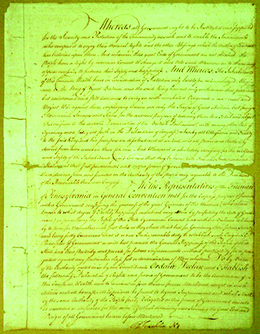| << Chapter < Page | Chapter >> Page > |
The task of creating republican governments in each of the former colonies, now independent states, presented a new opportunity for American revolutionaries to define themselves anew after casting off British control. On the state and national levels, citizens of the new United States debated who would hold the keys to political power. The states proved to be a laboratory for how much democracy, or majority rule, would be tolerated.
In 1776, John Adams urged the thirteen independent colonies—soon to be states—to write their own state constitutions. Enlightenment political thought profoundly influenced Adams and other revolutionary leaders seeking to create viable republican governments. The ideas of the French philosopher Montesquieu , who had advocated the separation of powers in government, guided Adams’s thinking. Responding to a request for advice on proper government from North Carolina, Adams wrote Thoughts on Government , which influenced many state legislatures. Adams did not advocate democracy; rather, he wrote, “there is no good government but what is republican.” Fearing the potential for tyranny with only one group in power, he suggested a system of checks and balances in which three separate branches of government—executive, legislative, and judicial—would maintain a balance of power. He also proposed that each state remain sovereign, as its own republic. The state constitutions of the new United States illustrate different approaches to addressing the question of how much democracy would prevail in the thirteen republics. Some states embraced democratic practices, while others adopted far more aristocratic and republican ones.
Visit the Avalon Project to read the constitutions of the seven states (Virginia, New Jersey, North Carolina, Maryland, Connecticut, Pennsylvania, and Delaware) that had written constitutions by the end of 1776.
The 1776 Pennsylvania constitution and the 1784 New Hampshire constitution both provide examples of democratic tendencies. In Pennsylvania, the requirement to own property in order to vote was eliminated, and if a man was twenty-one or older, had paid taxes, and had lived in the same location for one year, he could vote ( [link] ). This opened voting to most free white male citizens of Pennsylvania. The 1784 New Hampshire constitution allowed every small town and village to send representatives to the state government, making the lower house of the legislature a model of democratic government.

Conservative Whigs, who distrusted the idea of majority rule, recoiled from the abolition of property qualifications for voting and office holding in Pennsylvania. Conservative Whig John Adams reacted with horror to the 1776 Pennsylvania constitution, declaring that it was “so democratical that it must produce confusion and every evil work.” In his mind and those of other conservative Whigs, this constitution simply put too much power in the hands of men who had no business exercising the right to vote. Pennsylvania’s constitution also eliminated the executive branch (there was no governor) and the upper house. Instead, Pennsylvania had a one-house—a unicameral —legislature.

Notification Switch
Would you like to follow the 'U.s. history' conversation and receive update notifications?